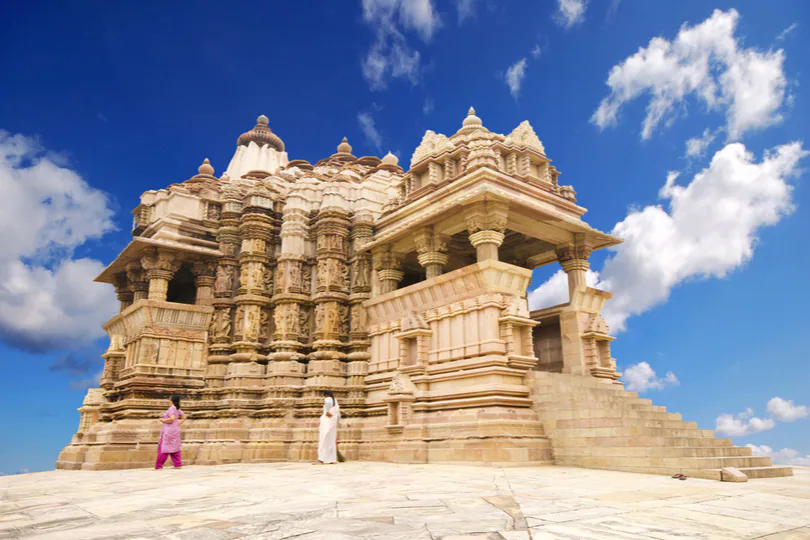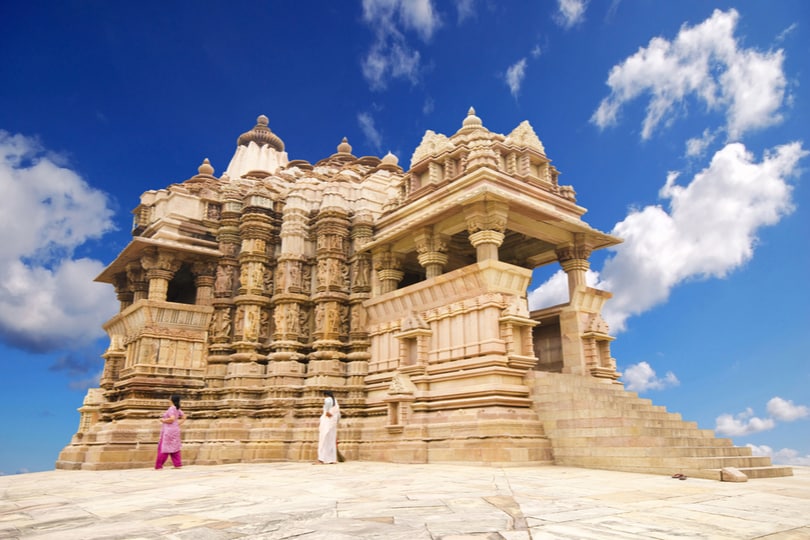

The Khajuraho temples in Madhya Pradesh exist bravely outside the box of your average temple town. This seems woefully inadequate as a description though, so perhaps we’ll try this again? The Khajuraho temples smash the average box to smithereens, taking on a form impossible to conceive or fathom.
One merely needs to mention Khajuraho to witness a spectrum of reactions: utter horror, absolute wonder, embarrassment, or juvenile snickering. While the route to most temple towns is potholed and dusty, the road to Khajuraho is lined with a canopy of trees and lush lawns. Wide, open roads welcome you to a different world – where sacred temples completely dismantle accepted norms of morality and sex. A site deeply sacred and venerated, while equally disturbing for the average person. If travel is meant to open up minds and challenge stereotypes, a trip to the Khajuraho temples aims to do that quite successfully!


The Khajuraho temples have seen a long road to recovery. Of the original 85 temples, only 20 survived the onslaught of invasions and time. The magnificent temples of Khajuraho were built between 950 to 1050 A.D. during the Chandela dynasty of Central India. The Chandela rulers claimed descent from the moon or ‘Chand’, the source of their name and power.
The temples were lost for centuries when the dynasty fell into ruins. Some fell to invasions by different empires, while time wore down the rest. A few temples remained inaccessible due to their remote locations. They were inadvertently protected from invading armies by dense forests over the centuries. It was only in 1838 that British engineer, Captain T.S. Burt, rediscovered these architectural marvels, leading to their subsequent protection and restoration.
The Chandela dynasty’s fortunes declined around the 13th century, leaving these temples under the cover of thick forests for hundreds of years. The name ‘Khajuraho’ is an extension of ‘Khajur’ or ‘Date’ in Hindi, after the date trees that sheltered these magnificent temples for centuries.
Within these temples lies a microcosm of existence itself. Exceptional architecture and sculptures depict all kinds of stories! Of battles won and fought, sport and friendship. Of meditation and spiritual teachings. Gods, goddesses, animals, and plants. Stories of music and dancing! Everlasting tales of love, marriage, and all possible kinds of lovemaking.
These temples redefine ideas of the sacred and profane. The infamous erotic sculptures comprise only 10% of the architecture in this stunning UNESCO World Heritage site. To dismiss them as erotic and ‘immoral’ (we’re looking at you, moral policemen and women) would be far more sacrilegious than the depictions of sex around the temple. The temples at Khajuraho are an unabashed celebration of the cosmic art of creation. With no coyness and pretense on how life is created, there’s much to imbibe from the refreshing and (dare we say) progressive worldview of the Chandelas.
The temples are a celebration of two religions: Hinduism and Jainism. In an increasingly polarised world today, temples such as Khajuraho are standing testaments to the beauty of co-existence.
The exquisite Khajuraho temples are divided into three groups: Western, Eastern and Southern. The temples are all built on high platforms, with towers and multiple halls within. None of the temples in Khajuraho are used for worship.
Out of the three, the Western Group is the largest one and recognized as a UNESCO World Heritage Site. Begin your exploration of the temples here, preferably early in the morning to beat the searing afternoon sun. It is in the Western Group that you will find some of the most famous Khajuraho temples: the Lakshmana Temple, Vishwanath Temple, the Kandariya Mahadeva Temple, the Devi Jagdambi Temple, and the Varaha Mandap.
The beautiful temples of Kandariya Mahadev and Vishwanath depict Khajuraho’s infamous erotic sculptures. The graphic sculptures depict all conceivable forms of sexual pleasures, eliciting both fascination and horror from tourists. Not for the faint-hearted, who’ve been known to quickly skip this part of the tour.
The Varaha Mandap is smaller in comparison and contains a carved statue of the boar Varaha that takes up the entire sanctum. It depicts less controversial scenes such as weddings, royalty, battles, and nymphs.
The elaborate Lakshmana Temple stands on a high platform and is surrounded by smaller temples on all four corners. The temple comprises beautifully-carved figures of humans and animals, some traces of erotica, and panels depicting life during the reign of the Chandelas.
It is recommended to hire the services of a licensed guide who is well-versed with the temples’ stories. Fair warning, detailed narrations of graphic sex scenes are part of the package.
As evening descends, make your way to the Southern and Eastern complexes, located in a different part of town. Since they are not enlisted with UNESCO, visitors are few and far between, giving more room for tourists to take in their beauty at a relaxed pace. These locations are almost untouched, with equally beautiful sculptures and carvings.
The Southern group comprises two main temples – Dulhadeo and Chaturbhuj. The Dulhadeo Temple stands tall on an expansive compound with beautiful lawns. The temple is dedicated to Lord Shiva and is one of the most beautiful sites in Khajuraho. Nearby is the Chaturbhuj Temple with Vishnu as the presiding deity. The Eastern group comprises Jain temples such as the Parsvnath complex.
For a glimpse into everyday life and culture, hop over to the picturesque villages nearby. Stop and chat with the friendly locals making their way home after a long day. Their villages are impeccably clean, with beautiful artwork adorning the walls of the houses.
While mornings and evenings are good times to explore the Khajuraho temples, afternoons are best spent indoors at the splendid museums here.
The Archaeological Museum, located conveniently next to the Western group of temples, is a treasure of archaeological discoveries found at Khajuraho. If the temples weren’t already fascinating enough, the museum with its statues, panels, and sculptures from Buddhist, Hindu, and Jain temples will leave you completely stunned.
While in Khajuraho, do not miss out on a spectacular cultural immersion at Adivart, the State Museum of Tribal and Folk Art. The museum is a must-visit with its wondrous collection of art from the Bundelkhand region: Gond art, Dokra figurines, terracotta, folk paintings, and colorful masks. The museum is located in the Chandela Cultural Complex.
If you have more time, do pay a visit to Shilpagram- a lively craft village run by the Ministry of Culture where something is always happening. Catch an exhibition or one of the many folk performances at this vibrant hub of culture.
Sound and Light Show – As night descends on Khajuraho, the Western Temples glisten in magical hues of red, yellow, and orange light. Prepare to be transported at the enchanting Sound and Light Show, that chronicles the remarkable history of Khajuraho.
As with everything in Khajuraho, it is a story that revolves around the moon. Of a union between the moon and a beautiful woman called Hemvati, leading to the birth of their love child, Chandravarman – the founder of the Chandela dynasty.
Set to the soothing strains of Indian classical music, the narrative explores wondrous stories of courage, honor, the king’s valor, and the rise of a powerful dynasty. But as is typical of the moon, the fortunes of the Chandela dynasty also waxed and waned rhythmically. Enchanting stories under the stars, amidst the beautifully-lit lawns of the Western Complex. We couldn’t think of a better way to wrap up a fantastic day at Khajuraho.
The Sound and Light show runs in both Hindi and English, beginning at 7.30 pm and 8.40 pm respectively. Tickets for the show are priced at Rs 200 for Indians and Rs 550 for foreigners.
Mediterraneo is a popular Italian restaurant for great pasta and wood-fired stone oven pizzas.
Raja Cafe has an extensive multi-cuisine menu that includes Indian, Western, and Asian dishes. It also has a great view of the temples and shaded rooftop seating.
Guru Kripa is run by a Jain family. Customers swear by their delicious vegetarian dishes.
Located very close to the Western Temples is Saffron, for good Indian food. Their menu includes both vegetarian and non-vegetarian options.
Lassi Corner is fantastic for that hearty, wonderfully-priced breakfast or snack.
Vayu’s Café and Safari Canteen also offer great food that is value for money.
Wildlife enthusiasts, stay on longer and plan a visit to the spectacular Panna National Park. If you’re chasing a story, there’s no better place than Pench Tiger Reserve in the Park – the setting for Rudyard Kipling’s The Jungle Book. While spotting the elusive cat would be anyone’s dream, there’s plenty more to see here: expansive forests, exotic migratory birds, leopards, snakes, antelope, and crocodiles! The Panna National Park is 94 km from Khajuraho.
Take the road less traveled to Orchha. Orchha means ‘hidden’ and seems to live up to its name. It is an untouched, medieval city with grand forts and palaces, located 172 km away from Khajuraho.
By Air: The nearest airport is the Khajuraho Domestic Airport, connected to cities such as Delhi, Mumbai, Varanasi, Allahabad, and Bhopal.
By Train: Khajuraho Railway station is connected to Delhi via the Khajuraho-Hazrat Nizamuddin Express. The second nearest railhead is Mahoba Junction.
By Road: Khajuraho has a well-connected bus service to different cities.
Noida, with its vibrant culinary scene, offers a plethora of options for dessert lovers craving…
Embarking on a journey? Make your travels more convenient and enjoyable with the latest accessories…
As the temperature drops and the chilly winds start to blow, staying warm and healthy…
Travel photography is not just about capturing moments; it's about immortalising experiences, landscapes, and the…
Embarking on a solo adventure can be exhilarating, offering the freedom to explore new destinations…
Business travel often entails tight schedules and hectic itineraries, leaving little room for packing mishaps…